
Dior
Dior is an historical French maison, founded in Paris in 1946 by Christian Dior and Marcel Boussac.
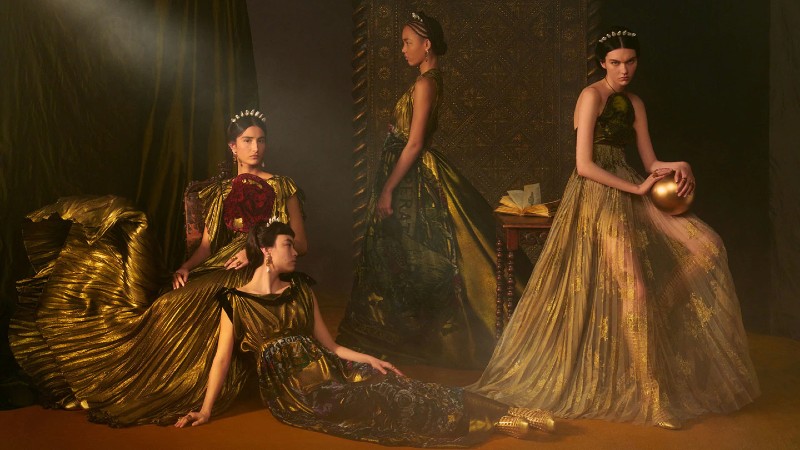
Index
- The origins: Christian Dior
1.1. Christian Dior fashion designer at Piguet and Lucien Lelong - The maison Dior
2.1. The new look
2.2. Avenue Montaigne 30
2.3. Dior is Dior: a splendid atelier - A new fashion designer: Yves Saint Laurent
- A new leadership: Bernard Arnault
4.1. Gianfranco Ferré at Dior
4.2. The years of John Galliano: theatricality at Dior
4.3. Dior Homme: Hedi Slimane - Financial information
- The centennial of Christian Dior
- Brand development
7.1. John Galliano Fired
7.2. Raf Simons
7.3. Maria Grazia Chiuri: a woman at Dior
7.3.1. 70 years of the maison
7.4. Kim Jones: streetstyle at Dior
The origins: Christian Dior
Christian Dior (1905 – 1957), tailor and fashion designer among the most important figures in French haute couture, was born in Granville, in northwestern France, where he spent a happy childhood: both in Paris and in Normandy, during his vacations, he was free to abandon himself to his genius for drawing and to a real talent in making costumes for carnival and for informal parties at home.

He already had a definite instinct for art and for the joy of living. His calling for artistic creation, supported by constant visits to museums and galleries, would emerge only later. After interrupting his university studies in Political Sciences and having put aside the idea of a diplomatic career, which was desired for him by his parents, he indeed started a partnership with his friend Jean Bonjean, owner of an art gallery in Paris, where the main figures of the various avant-guards of the 20th century exhibited their works.
Christian Dior fashion designer at Piguet and Lucien Lelong
His mother’s death and the bankruptcy of his father’s business changed his life, making his tormented youth the exact opposite of his happy childhood. In 1934 he seriously fell ill with tuberculosis and, after a one-year recovery in Spain, he went back to Paris and began to work on the fashion section of the weekly Le Figaro Illustré: he designed hats and began to sell sketches of clothing and accessories to several fashion houses. This lean period lasted 7 years, until 1938, when he found a steady job as fashion designer at maison Piguet: one of his first successes was a very full skirt that could be worn even in the daytime.
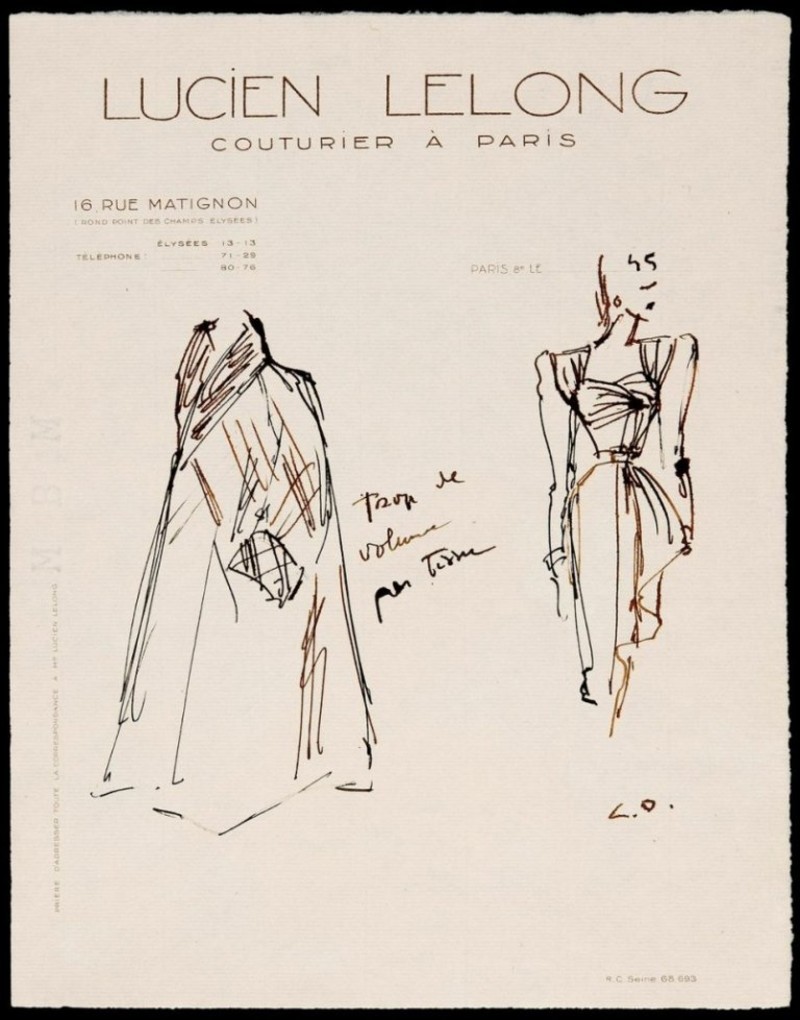
Then, the outbreak of World War II and his service with the army put a stop to everything. The signing of the armistice found him in the south of France, where he spent a year and a half in his father’s house, enjoying nature and the simple life of a village. Only the insistence of his friends convinced him to return to Paris, in 1941. His place at Piguet wasn’t there waiting for him, but he joined the maison of Lucien Lelong, where Pierre Balmain worked as an assistant too: there he designed collections for may seasons, by creating very tight skirts as well as flared skirts and so bringing success not only to Lelong, but to himself as well, because he became the head dress designer.
The maison Dior
It was 1946: he felt ready to manage his own maison and he knew he could count on an innate talent for business: he partnered with Marcel Boussac, who financed him with the considerable sum, at the time, of 60 million francs. In this adventure he was joined by some of Lelong’s key people, such as Raymonde Zehnacker, Marguerite Carré and Mitza Bricard. A young Pierre Cardin was hired as cutter and his team went to work immediately, in the building on Avenue Montaigne 30.
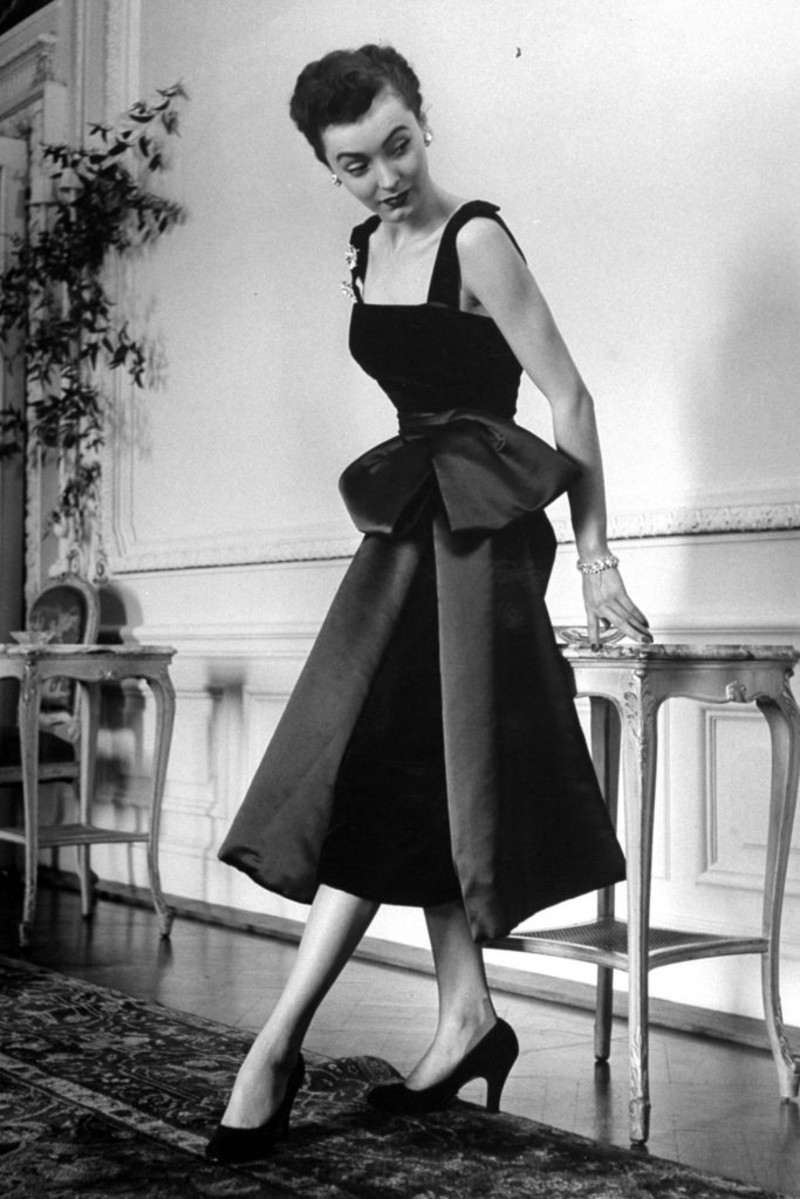
The new look
In collective memory, the name of Christian Dior is linked to the new look, which, on 12th February 1947, made him famous in one day. It was his first collection: after the morning presentation, he was pushed out on the balcony of his atelier at Avenue Montaigne to salute a crowd of applauding women. The Paris newspapers were on strike, so the explosion set off by Dior was felt first in America, where Carmel Snow, then director of Harper’s Bazaar, wrote “It’s a new look.”
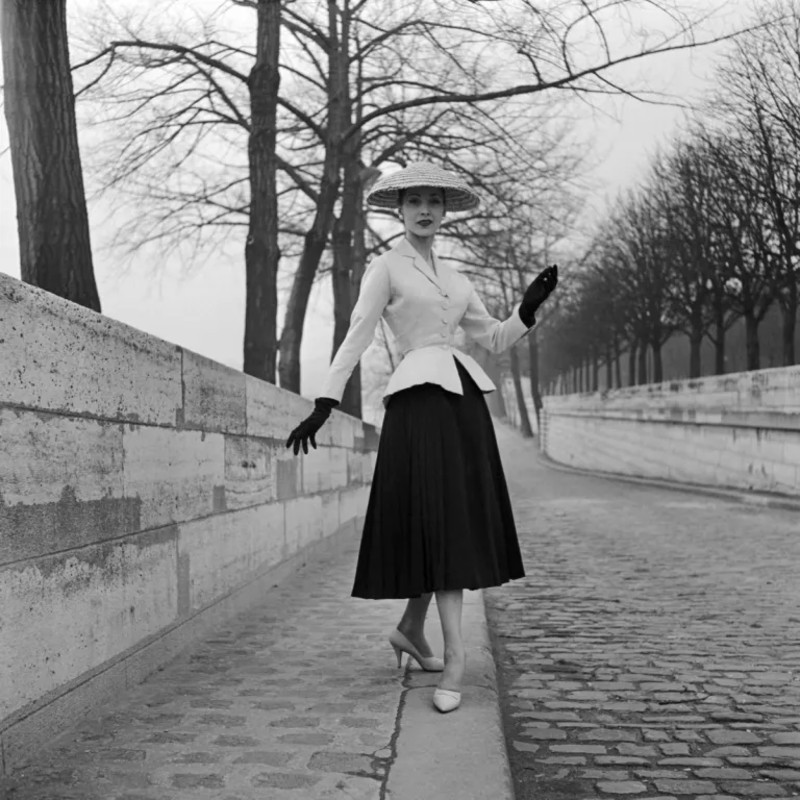
The woman offered in the Corolla line, later called New Look, was extremely new in its accentuated femininity, but with an antique touch: a very tiny waist (corset and girdle were back, with a sudden jump into the past), high breasts, small shoulders and long, full skirts with tulle petticoats to increase the bulk. It was a look backwards compared to the liberated body of Poiret and the one caressed by Chanel: it was a return to an aristocratic elegance and, from collection to collection, to the battle of hems.
Dior returned the fashion world back to femininity and launched immense, long blossoming skirts, with waists squeezed by small bodice-jackets, making half the women in Europe dream and tremble with trepidation. His intuition was striking, but his partnership with Marcel Boussac was crucial: the French textile entrepreneur had everything to gain from a lifting of the wartime restrictions on fabrics and Dior’s swaying skirts were right for him, because they consumed more than 16 yards of fabric, while an evening dress took as much as 27 yards.
Avenue Montaigne 30
Avenue Montaigne 30 is the address still today considered magical and pivotal in the expansion and increase in places and regions of such a charismatic empire, whose charm has always been respectful of the furnishings and atmosphere chosen by Dior, with Louis XV armchairs with the grey-and-white medallion that was a symbol of the maison on the back. Another motif associated with Dior was the lily of the valley, used in Dior’s first perfume, Diorissimo, in 1948, and later sprayed generously on the pearl grey fitted carpet in the days of Dior’s many presentations.
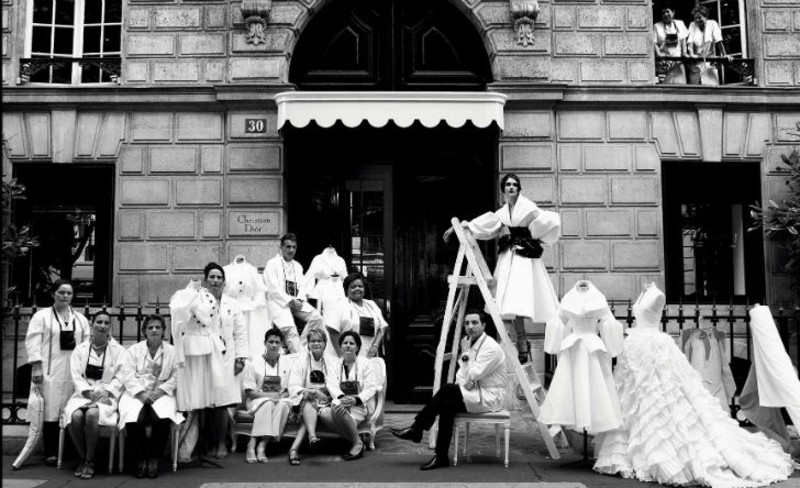
Dior is Dior: a splendid atelier
The object of both praise and invective, Dior had, by now, become Dior: a splendid atelier with a staff of 85 workers. He could change his style, and he did, naming many lines after letters of the alphabet, such as the H, A, and Y lines. He was able to revive the artisanal skills of the petites mains and could amaze people with hard-to-figure-out technical devices which could make the cut of a garment crushproof.
When Dior was awarded with the recognition of Neiman Marcus, received in America, the fashion designer adjusted his approach to appeal to a more dynamic post-war woman: he lifted the skirts at the back (1948), cut soft jackets and presented tapered skirts (1949), making them shorter the following year and matching them with sack-shaped jackets with a horseshoe neck. In 1954 silhouette became softer: in H line waists were no longer squeezed and the sack dress was about to begin.
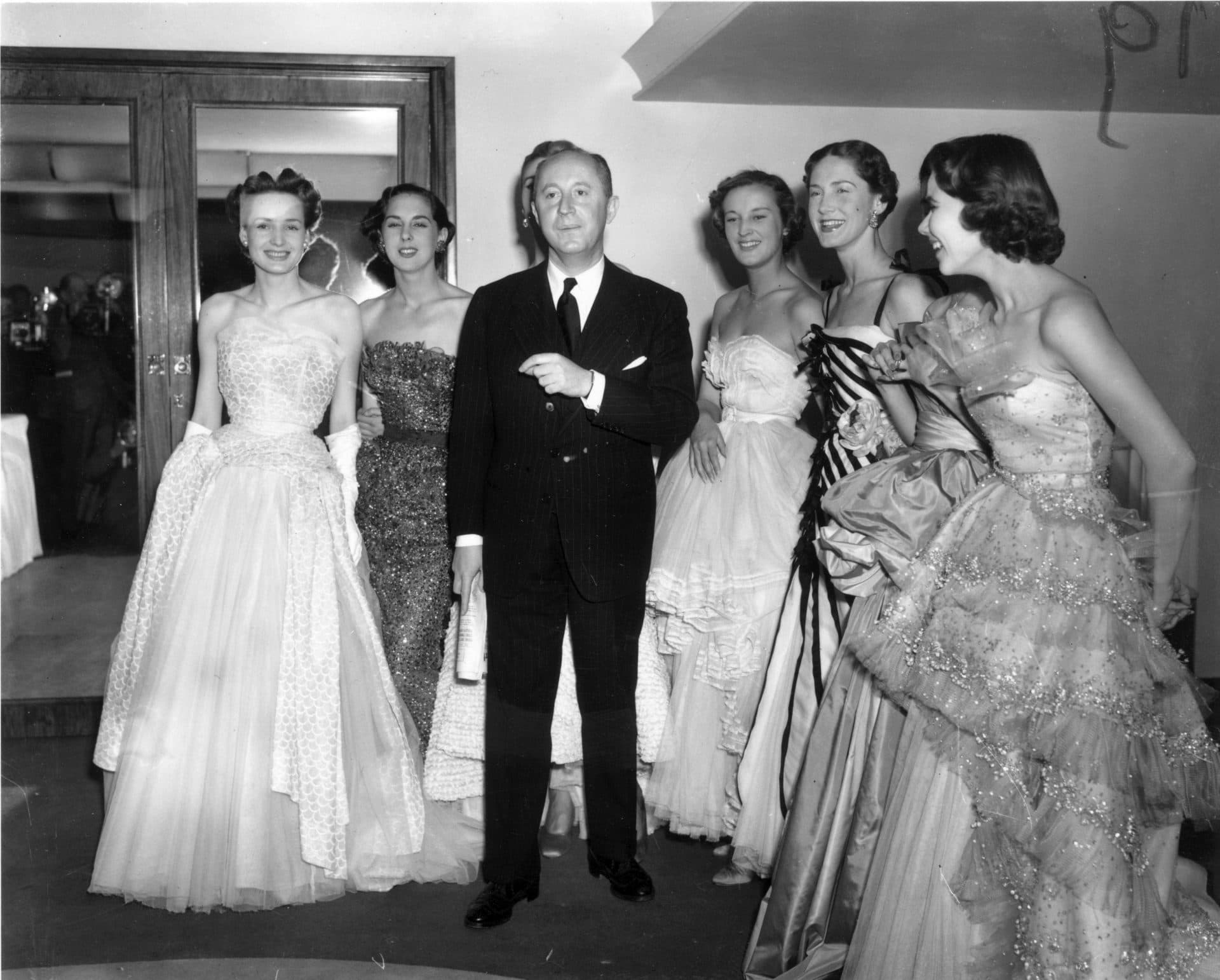
In 1955 the A line and the Y line came, with the dominating motifs of large V necks and dresses matched with immense stoles. In that same year his pursuit on caftan had a marked effect on fashion, with a delicate high-waist chiffon dress and a sheath dress as tight as a corset. From perfumes to prêt-à-porter, from accessories to underwear, with licenses and new boutiques in Latin America and Cuba, Dior seemed to want to put every possible avenue of distribution under his own name in order to guarantee its long life.
A new designer: Yves Saint Laurent
In 1957 the maison presented Dior’s last collection, a variation on the theme of the vareuse, a kind of blouse with buttoned flap pockets that falls loosely at the sides and is often worn with a khaki safari jacket. Christian Dior passed away in the Summer of 1957, in Montecatini. He became immortal and created one of the most admired haute couture empires in just ten years, from 1947 to 1957.
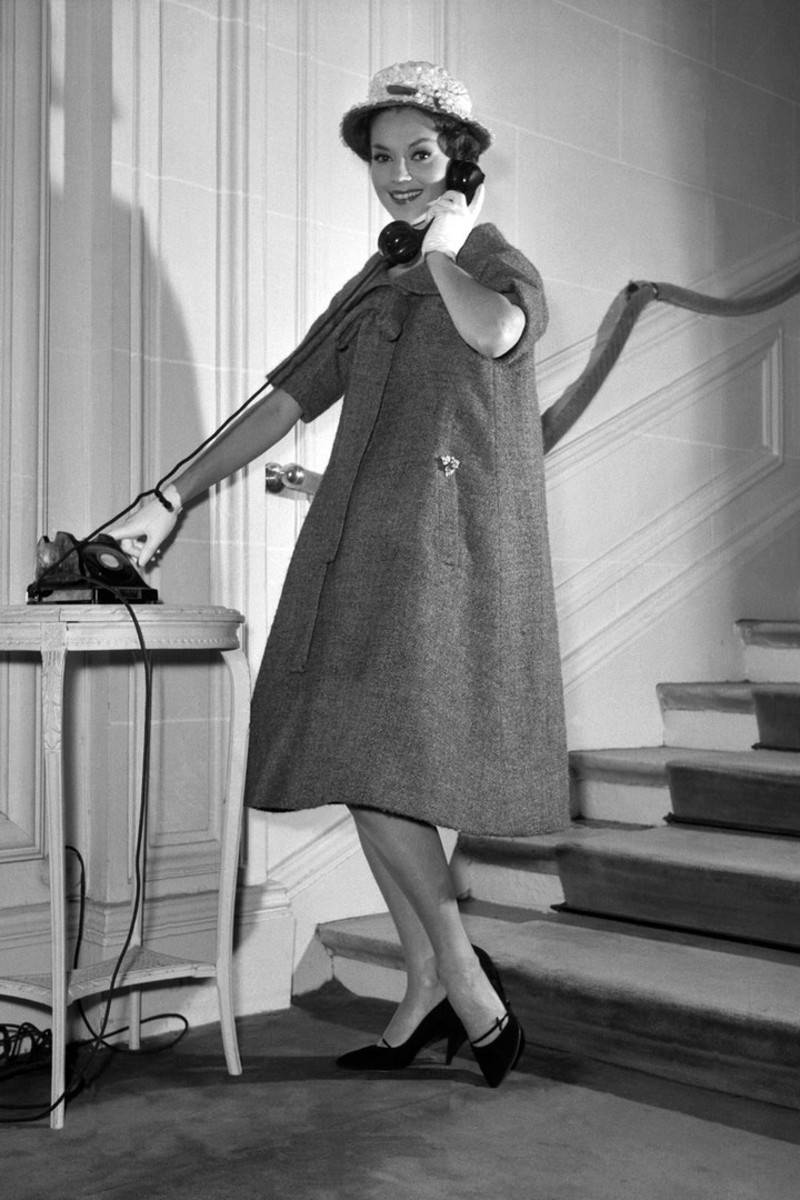
The 1958 collection, called Trapezio, was a triumph. It was designed by Yves Saint-Laurent, who three years before had become Dior’s assistant and heir; called for military service in 1960, Saint-Laurent, after his return, created his own atelier, as his place at Dior had been taken by Marc Bohan, who expressed, over thirty years, the spirit of the founder in a measured and creatively elegant way.
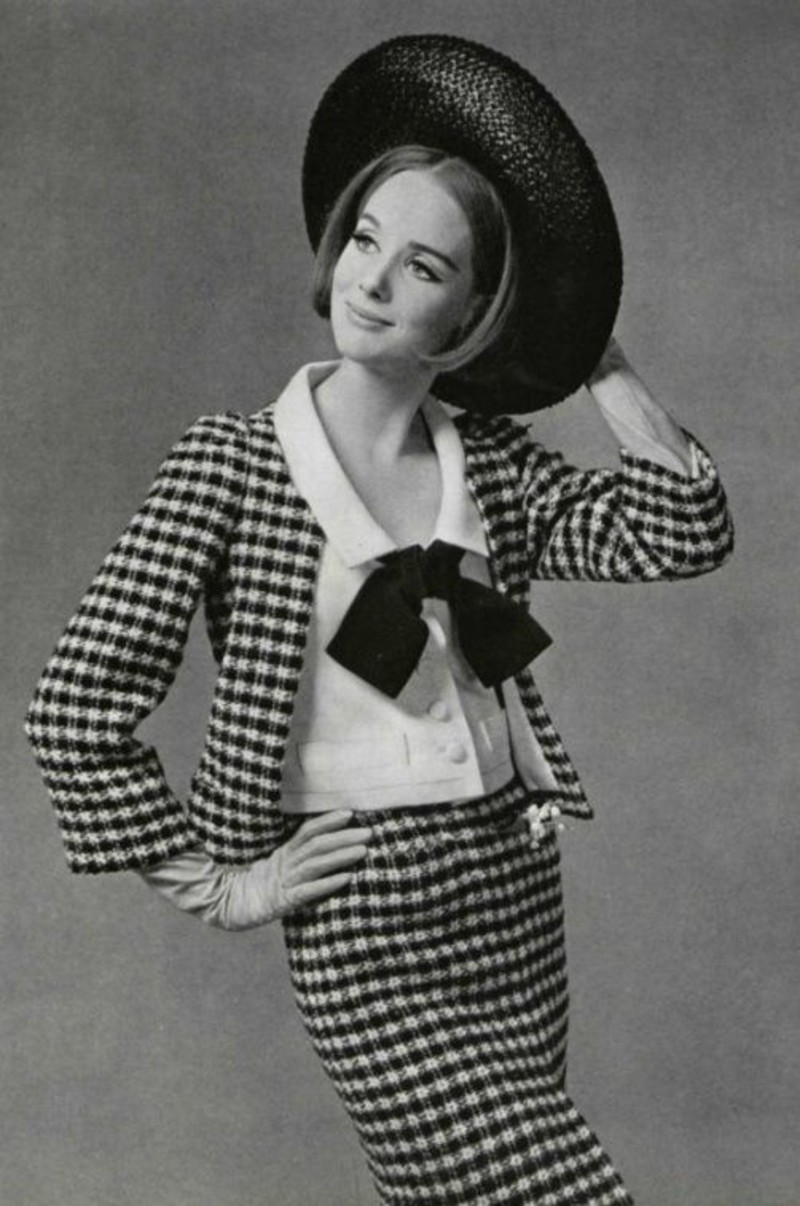
A new leadership: Bernard Arnault
In 1988, a big retrospective at the Pavillon Marsan in the Musée des Arts de la Mode at the Louvre celebrated Dior and the new leadership of Bernard Arnault, the wizard of the luxury goods business. In that same year, the maison opened its first boutique in New York. The following year, Marc Bohan left.
Gianfranco Ferré at Dior
In 1989 Gianfranco Ferré went to Avenue Montaigne 30, becoming the first Italian Creative Director of the fashion house.In four annual collections of high fashion and prêt-à-porter, some of which were memorable and inspired by revived images of early Dior, gradually emphasizing a timeless luxury that was daring and magic in its opulence, Ferré developed a range of creativity suitable to both the time and to the prestige of the illustrious maison, marked by the perfumes Dune and Dolce Vita: in his creations the codes of the maison meet sumptuous fabrics, rich colors and clear cuts.

The years of John Galliano: theatricality at Dior
In more recent times, after Ferré left, the stamp of impeccable beauty of the griffe wasn’t always expressed by collections designer by John Galliano. The man, who was appointed Creative Director in 1996, was surely more inclined to irony and excesses than to voluptuous grace of Dior perfection. Galliano brought to the French maison genius and excess, by presenting fashion shows which were characterized by theatricality: that was the golden age of high fashion or, at least, he would be so until 2011.
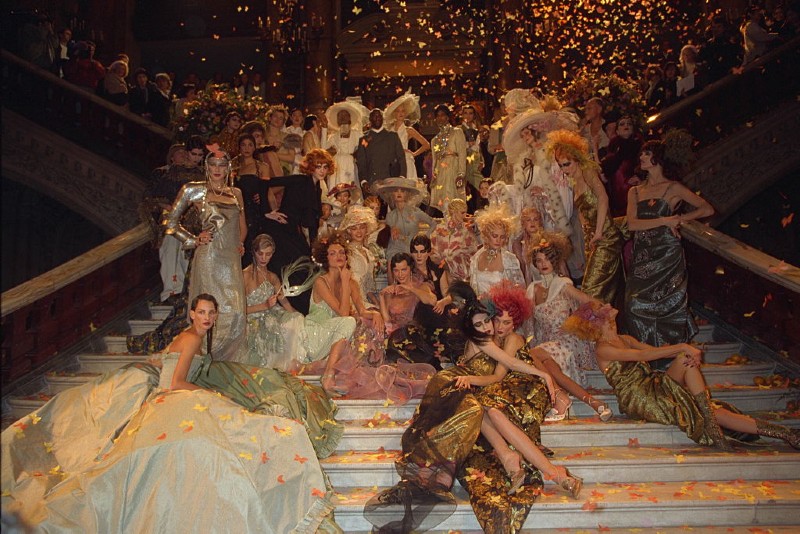
Dior Homme: Hedi Slimane
In 2000, after his experience at Saint Laurent, Hedi Slimane was called for a new project, the Homme line, which was a success: his style was appreciated by the greatest one, Karl Lagerfeld in primis. Rock and streetstyle met the tailoring of Dior and skinny cuts. In 2006 Slimane, who in June 2002 was named best fashion designer of the year by the Council of Fashion Designers of America, left Dior, replaced by Kris Van Assche.
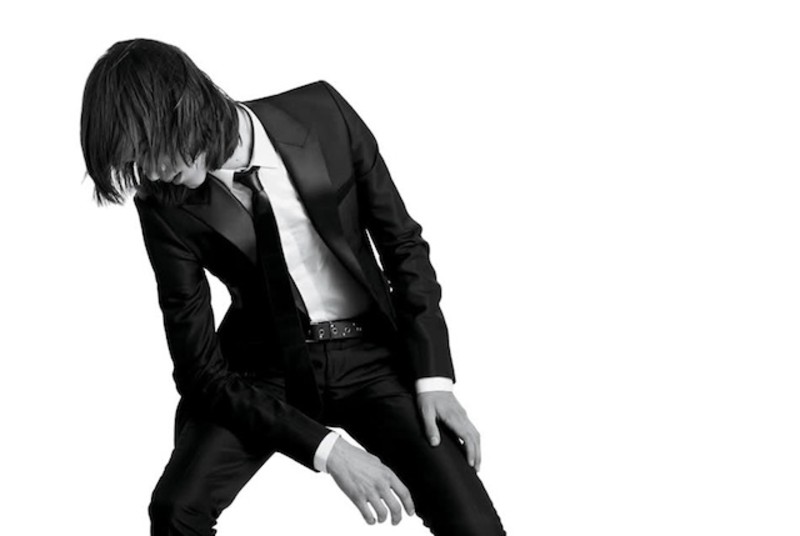
Financial information
In January 2002 Dior renewed Sàfilo‘s license to produce and distribute the eyeglass collection manufactured by them since 1996. After a profit of 251 million euros in 2000, 2001 closed with a deficit: Christian Dior SA Holding, owned 65% by Bernard Arnault, showed a loss of 95 million euros, in spite of a 6% increase in sales and revenues of 12.567 billion euros. The loss was attributed to reorganization costs of the retail operations and to investments needed to reorganize the USA business after 11th September 2001.
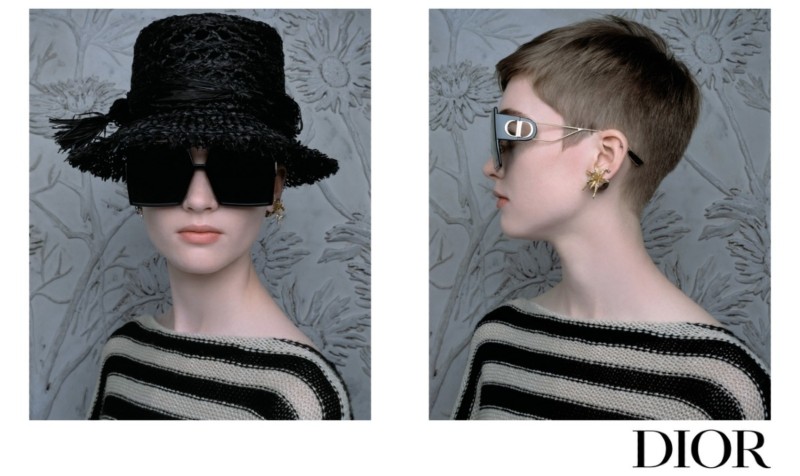
In April 2002 Dior opened a store in Rome, in one of the most evocative places in the city, the corner between via Condotti and Piazza di Spagna, with a small space is reserved for the jewellery designer Victoire de Castellane. At the end of 2002, after the osso in 2001, the company showed a net profit of 178 million euros.
In March 2003 Vincenzo Moccia, 43 years-old, became Director of Dior Italy, after having been Director of Bulgari Italy and of Gucci for northern Italy. The Italian market contributed with a turnover of 492 million euros (an increase of 41%) and an operating profit of €33 million.
The centennial of Christian Dior
2005 marked the centennial celebration of Christian Dior’s birth: the French Minister of Culture, Renaud Donnedieu de Vabres, inaugurated the exhibit L’Homme du Siècle in Granville, in Dior’s childhood home, Villa Les Rhumbs, nowadays Musée Christian Dior. The celebrations continued in Paris, during the fashion week, with a show that covered Dior’s entire life, with his history, the theater the little boy Christian in a sailor’s suit and so on, until his success with the divas who visited his atelier. The show was played by top models of the time, who also mentioned his passion for dancing and Peru.
Brand Development
In April 2008 Sidney Toledano, President and CEO of Christian Dior Couture, announced the appointment of Delphine Arnault Gancia as general Vice Director of Christian Dior Couture. In 2008, Christian Dior Group recorded sales for 8.2 billion euros, gaining 11% compared to the previous year and a net income of 352 million euros. All this is mostly due to emergent markets such as China, Russia and Middle East.
In 2009, Dior launches the new advertising campaign for the Lady Dior bag, with the french actress Marion Cotillard as testimonial. In the same year Camille Miceli, appointed Creative Director of costume jewellery and artistic advisor, entered the group, after nine years, the high jewellery and watches store reopened in the French capital.
In 2010, Christian Dior and Safilo Group announces that their license agreement for design, world wide production and distribution of the Dior eyewear and sunglasses collection has been extended to december 31 2017. This year, the revenues amounts to €21.1 billion with an increase of 19% compared to 2009, due to the good performances in Europe, Asia and Usa. On these bases, Christian Dior announces the project of opening and renewal of boutiques on high potential markets.
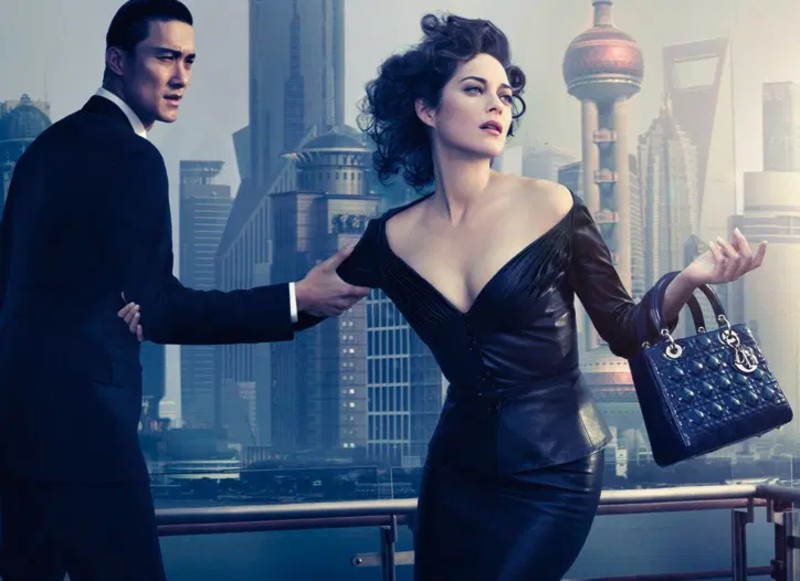
In 2010 Christian Dior and Sàfilo announced that their license for design, production and worldwide distribution of eyeglasses would be extended to 31th December 2017. The turnover was 21.1 billion euros (+19 % compared to 2009), also due to good performances in Europe, Asia and USA: on the basis of this, Dior announced the opening or renovation of many boutiques in high potential markets.
John Galliano Fired
In 2011, after having been Creative Director of the maison for 15 years, John Galliano was fired because of antisemitic and racist insults pronounced in a drunken rant. His Autumn/Winter 2011 fashion show went on without him, at the Paris Fashion Week.
Raf Simons
In 2012 Raf Simons was appointed Creative Director: the Belgian designer became responsible of the women Haute Couture collections, prêt-à-porter and accessories. The maison declared that Simons would project the style of the maison towards the 21th century, giving life to a real change. In his first collection the tradition of the maison was revisited in a modern and architectural key, with a minimalism very far from the style of Galliano. The fashion designer astonished with one of the best collections of the brand, showing his ability of mixing modernity with history.
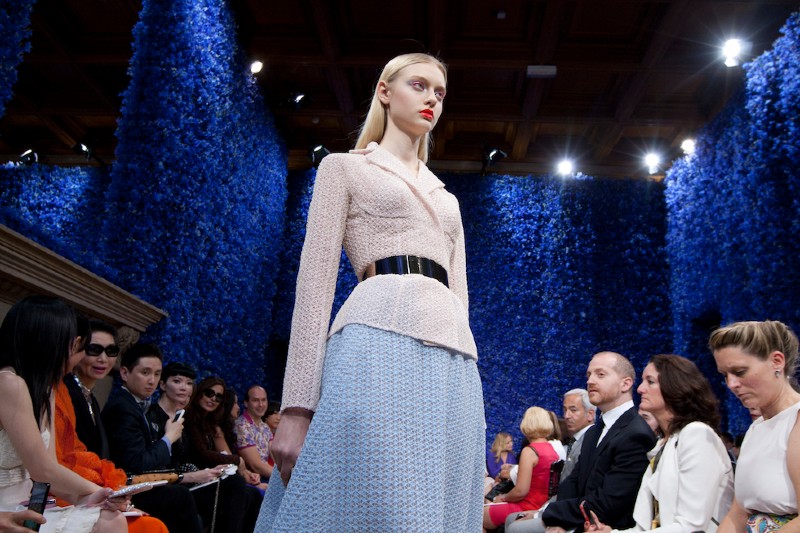
In 2012 Dior launched its first online magazine, called Diormag: news on the website were daily updated with informations regarding the global activities of the griffe.
After one year from the appointment of Raf Simons, Christian Dior Couture revealed that profits had increased of 31% and incomes of 14%: such results were also due to the influence of Kris Van Assche, Creative Director of menswear department. In spite of this, Delphine Arnault Gancia, daughter of Bernard Arnault, head of LVMH group, announced her decision to give up her collaboration with the maison to work exclusively for Louis Vuitton.
In 2014, during an interview, Sidney Toledano confirmed that their success came from the very high quality of production, exalting Made in Italy and promoting productive firms also in Veneto and in Tuscany.
In 2015 Raf Simons decided to engage popstar Rihanna as testimonial for the Secret Garden campaign: it was a big step forward, as in seventy years she was the first black woman to collaborate with the brand. Serge Brunschwig, Dior Chief Operating Officer, achieved the role of Dior Homme division President; in the same year, Dior, together with Chanel and Louis Vuitton, was in the lead of the ranking made by Brandwatch considering the best and the more influential brands on social media.
Maria Grazia Chiuri: a woman at Dior
After 3 years, in October 2015, Raf Simons decided not to renew his contract and to leave Dior because of personal reasons. The inside team of the French griffe, which included fashion designers Lucie Meier and Serge Ruffieux, was asked to design the Spring/Summer 2016 Couture and the Autumn/Winter 2016/2017 prêt-à-porter collections. Because of the exit of Raf Simons, the revenues showed a slight slowdown in the second semester of the exercise, with sales for 961 million euros.
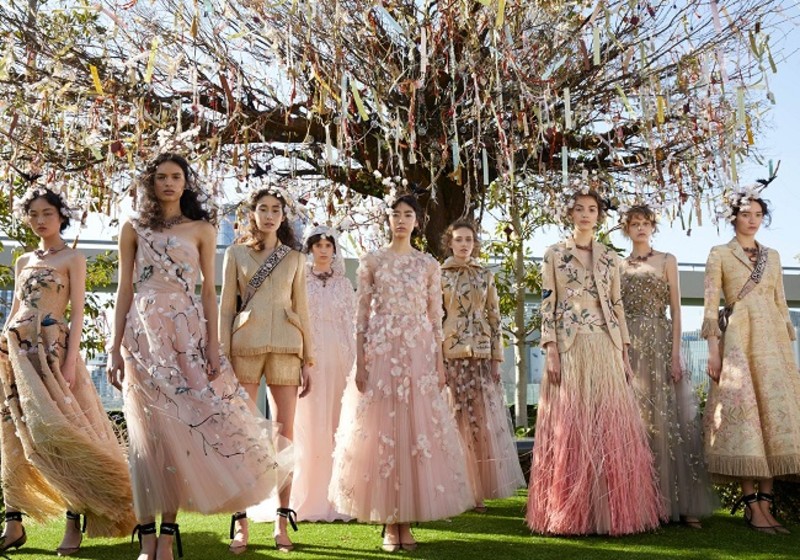
Then, in July 2016, Maria Grazia Chiuri became the first female Creative Director of Dior: a woman with a long career in fashion, first for Fendi and then for Valentino, always close to Pierpaolo Piccioli, in her first fashion show (Spring/Summero 2017 collection), after romantic and finely decorated dresses, she made a iconic T-shirt appear, which, because of its writing We should all be feminists, became the most shared item on Instagram and Twitter. This simple T-shirt, whose price was 550 euros and which was immediately sold out, became a discussed media case and cause her the title of “activist fashion designer”.
In 2023, it was Maria Grazia Chiuri who rediscovered the historical pattern Plan de Paris, designed by Christian Dior for a foulard in the ’50s and today impressed in the Dior Book Tote bag.
70 years of the maison
In 2017 the 70 years of Dior were celebrated: the French maison organized the exhibition Christian Dior: designer of dreams, curated by Florence Müller and Olivier Gabet, which hosted 300 breath-taking dresses to tell the history of the fashion house.

Kim Jones: streetstyle at Dior
In 2018, after his experience in Louis Vuitton, Kim Jones entered Dior Homme. His debut in 2018 marked the beginning of a new era for the Dior man, who met streetstyle and urban world. Collaborations are part of his artistic DNA: so, when he arrived at Dior, he involved many personalities, such as American artist Kawn, Japanese Hajme Sorayama, famous because of his robot women in pin-up style, Ghanaian Amoako Boafo and Kenny Scharf, who is an uncontested protagonist of the pop scene of the ’80s, together with Basquiat and Keith Haring.
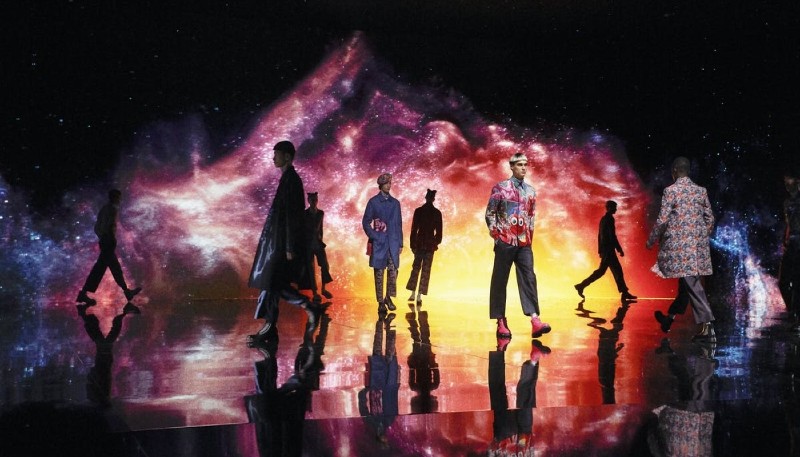
During last years Dior doubled its turnover, moving from 3 billion euros (2017) to 5,8 billion euros (2021): this growth was crowned, in 2022, by the reopening of the historical headquarters in Avenue Montaigne 30: after a two-years renovation, the headquarters reopened with a new guise, designed by Peter Marino. It’s a huge flagship store, which includes: a boutique and all the collections by Dior, a beauty section, a Gallery hosting archive items, Haute Couture and High Jewelry laboratories, a restaurant, a pastry-making, three gardens and the Suite Dior.
In 2022, Dior generated 79.4 billion euros in revenue, more than 20 billion euros in operating profit and over 10 billion euros in cash flow.
You may also like:
Contacts
To read the item in Italian click here.

FRATELLI ROSSETTI

